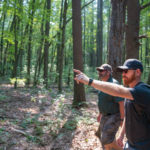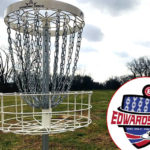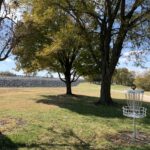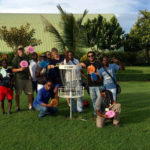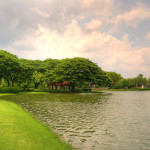A Blank Canvas for Disc Golf
Take a walk through your local park. What do you see?
Do you see birds chirping, children playing and trees blowing softly in the wind? Maybe there is a crowded playground, or a happy couple walking their dogs on a bike path. It’s a pretty picture, right?
2010 PDGA World Champion Eric McCabe sees all of this too. But when he looks, he also sees something more.
McCabe sees a winding dogleg ending in an elevated basket. He envisions a tee pad leading to a wide-open, Par-5 hole that demands extraordinary strength and skill to complete. Each nook and cranny can be used. Every elevation and depression, every tree line and open field is untapped potential.
It’s a blank canvas. And McCabe, leading designer for Dynamic Course Design, loves the opportunity to add his own brush strokes.
“I will not turn down a revamp design, but there is not a greater feeling than a start-to-finish design,” he explained. “Revamping can be difficult, mainly because if the course has any nostalgia there will always be someone that doesn’t like the idea.
“With a new course, it’s much more rewarding being able to put your own twist on things.”
McCabe’s process for transforming a piece of property into a disc golf course starts with learning the lay of the land. Thanks to technologies like Google Earth, he is able to begin that process before he even steps foot on a new project. Once he does arrive on location, McCabe can truly begin the work of visualizing the new course, identifying problem areas and crafting ways to utilize unique land features on the property.
 In the case of one of his more recent designs, The Hollows Disc Golf Course in Manchester, N.H., McCabe spent a over a week simply traversing the terrain and mentally mapping the property. From initial discussions to final product, courses usually take around a month to complete. McCabe feels that acclimating himself with the land at his disposal is essential to achieving his vision for a new design.
In the case of one of his more recent designs, The Hollows Disc Golf Course in Manchester, N.H., McCabe spent a over a week simply traversing the terrain and mentally mapping the property. From initial discussions to final product, courses usually take around a month to complete. McCabe feels that acclimating himself with the land at his disposal is essential to achieving his vision for a new design.
“I’ll even carry a few discs with me to throw and make sure distances will work and such,” he said. “This is probably my favorite and most exciting part of the process.”
But McCabe doesn’t just visualize catering to experts when he designs a new course. Multiple pin placements and amateur tee pads are just a few of the tools he utilizes to help disc golfers of all skill levels feel comfortable. McCabe also envisions year-round use of his courses, meaning he must consider how a hole will look as fall turns to winter, and the cold winds eliminate obstacles such as leafy bushes and trees. Designing to anticipate the changing seasons is no small task.
“Foliage can, and will, vary from season to season,” McCabe said. “This is something you have to consider if designing a course in the Winter months. A couple other difficulties include areas that may flood, or become soggy through the year.”
The design process is fluid and collaborative, and McCabe relishes the challenge of collaborating with a client to create a truly unique disc golf experience. No matter what tools he uses, or what obstacles he must account for, the overall picture McCabe aims to paint with his designs always remains the same. If you play one of his courses, you will be challenged.
But you will also have a lot of fun.
“For an EMAC Championship Course, I like to use as much of the property as possible,” McCabe said. “Elevation and woods are an advantage, and when you put them together you’ve got something special.
“The overall goal is to simply have a quality course that everyone can enjoy.”
If you are interested in a course redesign or installing a new course let us know more info about your project.
– Blake Bacho


